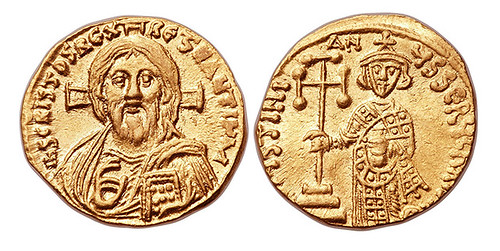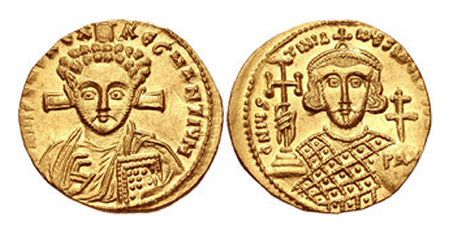
PREV ARTICLE
NEXT ARTICLE
FULL ISSUE
PREV FULL ISSUE
THE IMAGE OF JESUS ON ANCIENT COINSI enjoy Mike Markowitz's article on ancient coinage. His December 11, 2017 piece looks at the image of Jesus on ancient coins. Here's a short excerpt - be sure to read
the complete article online. -Editor
Justinian II, Part 1  Justinian II, first reign (AD 685-695). AV solidus This image, often described as Christ Pantocrator (“Ruler of all things”) ultimately derives from the gold and ivory statue of Zeus in the temple at Olympia, created by the sculptor Phidias circa 435 BCE[5]. The reverse depicts the standing figure of the emperor with the inscription “Justinian Servant of Christ”. This remarkable change in the coinage may have been a gesture of defiance toward the Muslims, who recognized Jesus as a prophet, but rejected His divinity. Examples of this famous coin, even if poorly struck and off-center, are in high demand. High-quality specimens typically bring $5,000 or more at auction[6]. On Harlan Berk’s list of the 100 Greatest Ancient Coins, this type is #77 (Berk, 114). Fractional denominations were struck with the same design (the semissis worth half a solidus and the tremissis worth a third) but are quite scarce. Justinian II, Part 2 There was another dramatic change in the coinage, for reasons unknown.  Justinian II, second reign (AD 705-711), with Tiberius. AV solidus. To read the complete article, see: Wayne Homren, Editor The Numismatic Bibliomania Society is a non-profit organization promoting numismatic literature. See our web site at coinbooks.org. To submit items for publication in The E-Sylum, write to the Editor at this address: whomren@gmail.com To subscribe go to: https://my.binhost.com/lists/listinfo/esylum All Rights Reserved. NBS Home Page Contact the NBS webmaster 
|